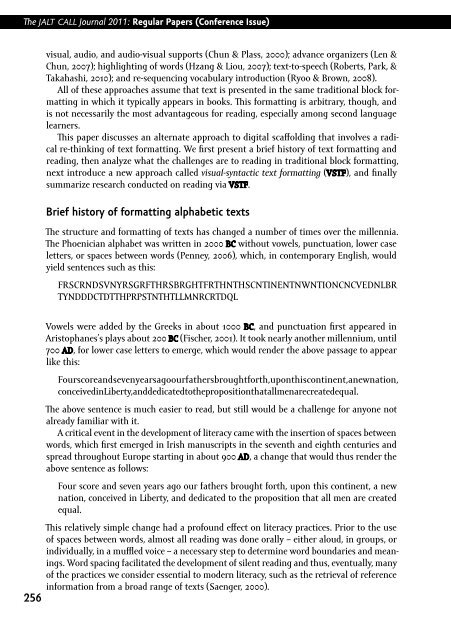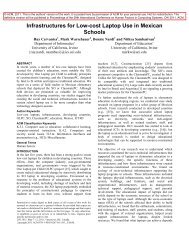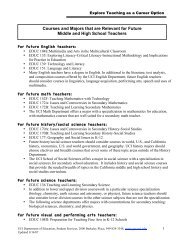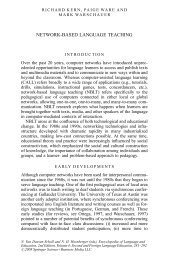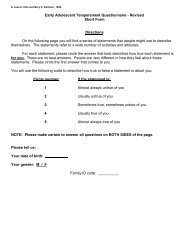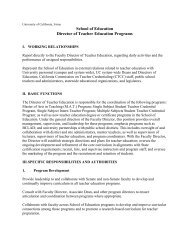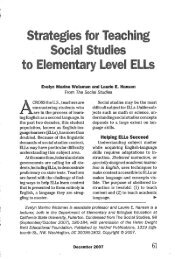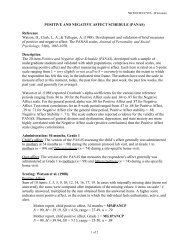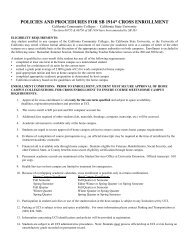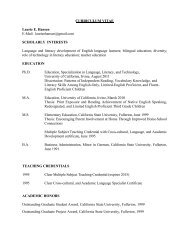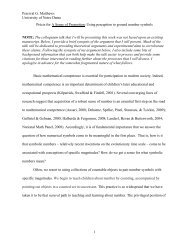Transforming digital reading with visual- syntactic text formatting ...
Transforming digital reading with visual- syntactic text formatting ...
Transforming digital reading with visual- syntactic text formatting ...
Create successful ePaper yourself
Turn your PDF publications into a flip-book with our unique Google optimized e-Paper software.
The jalt call Journal 2011: Regular Papers ( Conference Issue )<strong>visual</strong>, audio, and audio-<strong>visual</strong> supports (Chun & Plass, 2000); advance organizers (Len &Chun, 2007); highlighting of words (Hzang & Liou, 2007); <strong>text</strong>-to-speech (Roberts, Park, &Takahashi, 2010); and re-sequencing vocabulary introduction (Ryoo & Brown, 2008).All of these approaches assume that <strong>text</strong> is presented in the same traditional block <strong>formatting</strong>in which it typically appears in books. This <strong>formatting</strong> is arbitrary, though, andis not necessarily the most advantageous for <strong>reading</strong>, especially among second languagelearners.This paper discusses an alternate approach to <strong>digital</strong> scaffolding that involves a radicalre-thinking of <strong>text</strong> <strong>formatting</strong>. We first present a brief history of <strong>text</strong> <strong>formatting</strong> and<strong>reading</strong>, then analyze what the challenges are to <strong>reading</strong> in traditional block <strong>formatting</strong>,next introduce a new approach called <strong>visual</strong>-<strong>syntactic</strong> <strong>text</strong> <strong>formatting</strong> (VSTF), and finallysummarize research conducted on <strong>reading</strong> via VSTF.Brief history of <strong>formatting</strong> alphabetic <strong>text</strong>sThe structure and <strong>formatting</strong> of <strong>text</strong>s has changed a number of times over the millennia.The Phoenician alphabet was written in 2000 BC <strong>with</strong>out vowels, punctuation, lower caseletters, or spaces between words (Penney, 2006), which, in contemporary English, wouldyield sentences such as this:FRSCRNDSVNYRSGRFTHRSBRGHTFRTHNTHSCNTINENTNWNTIONCNCVEDNLBRTYNDDDCTDTTHPRPSTNTHTLLMNRCRTDQL256Vowels were added by the Greeks in about 1000 BC, and punctuation first appeared inAristophanes’s plays about 200 BC (Fischer, 2001). It took nearly another millennium, until700 AD, for lower case letters to emerge, which would render the above passage to appearlike this:Fourscoreandsevenyearsagoourfathersbroughtforth,uponthiscontinent,anewnation,conceivedinLiberty,anddedicatedtothepropositionthatallmenarecreatedequal.The above sentence is much easier to read, but still would be a challenge for anyone notalready familiar <strong>with</strong> it.A critical event in the development of literacy came <strong>with</strong> the insertion of spaces betweenwords, which first emerged in Irish manuscripts in the seventh and eighth centuries andspread throughout Europe starting in about 900 AD, a change that would thus render theabove sentence as follows:Four score and seven years ago our fathers brought forth, upon this continent, a newnation, conceived in Liberty, and dedicated to the proposition that all men are createdequal.This relatively simple change had a profound effect on literacy practices. Prior to the useof spaces between words, almost all <strong>reading</strong> was done orally – either aloud, in groups, orindividually, in a muffled voice – a necessary step to determine word boundaries and meanings.Word spacing facilitated the development of silent <strong>reading</strong> and thus, eventually, manyof the practices we consider essential to modern literacy, such as the retrieval of referenceinformation from a broad range of <strong>text</strong>s (Saenger, 2000).


